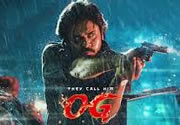They Call Him OG
Cast:
Pawan Kalyan, Prakash Raj, Emraan Hashmi, Priyanka Arul Mohan
Director:
Sujeeth
Genre:
Action
Play time:
02:31:00
Synopsis:
After vanishing from Mumbai's underworld for a decade, mob boss Ojas Gambheera resurfaces seeking vengeance against rival crime lords.
Movie Review:
What unfolds on screen is a star-driven, masala-packed entertainer anchored by a charismatic lead whose screen presence rarely falters. The film thrives on a tried-and-tested formula: a larger-than-life protagonist with a turbulent past, a web of political and criminal conflicts, and a supporting cast that adds texture to each turn. The narrative pushes forward with brisk action set-pieces and confrontation-heavy scenes where the lead’s moral code and flawless delivery keep the audience invested even when the plot stretches believability.
Performances are the film’s strongest asset. The central actor carries the film with an effortless blend of swagger and vulnerability — his comic timing and stormy intensity alternate with ease, giving the character shades rather than a single-note persona. The antagonist, portrayed with measured menace, raises the stakes in their shared scenes; their sparring is a highlight, providing genuine sparks whenever the script allows them to trade barbs or collaborate on tense set-pieces. Supporting turns are dependable: the romantic lead brings warmth and grounded innocence, while the ensemble of veteran performers supplies gravitas and occasional comic relief. Even smaller roles are well-cast, and a few emotionally charged moments get unexpectedly strong support from character actors who make every line count.
Technically, the film is slick. The cinematography favors wide, dramatic frames for action and close, intimate shots for the quieter moments, delivering a visual language that matches the story’s swings between spectacle and sentiment. Action choreography is lean and impactful — not always realistic, but choreographed to maximize excitement. The background score punctuates key emotional beats and fight sequences effectively, although at times it leans heavily on familiar motifs rather than surprising choices. Production design and costume work complement the protagonist’s world, establishing class and power dynamics without overstaying their welcome.
On the writing front, the screenplay is efficient but occasionally predictable. The story doles out twists and revelations at measured intervals, yet several beats follow well-worn genre conventions. Dialogue alternates between razor-sharp lines that land hard and expository stretches that slow the momentum. Pacing is mostly steady, but the film could trim a couple of mid-section scenes to tighten the narrative drive. That said, its emotional core — a portrayal of loyalty, sacrifice, and a search for redemption — lands in moments where performances are allowed to breathe, and those scenes resonate beyond the expected melodrama.
Romance and family dynamics get fair screen time, blending sentiment with the protagonist’s conflict-ridden life. The chemistry between the leads is believable and adds stakes to the central character’s choices. Comic beats are sprinkled through the script in ways that relieve tension without undermining the dramatic arcs. The film balances its tonal shifts well overall, even if it occasionally slips into melodramatic territory.
Performances are the film’s strongest asset. The central actor carries the film with an effortless blend of swagger and vulnerability — his comic timing and stormy intensity alternate with ease, giving the character shades rather than a single-note persona. The antagonist, portrayed with measured menace, raises the stakes in their shared scenes; their sparring is a highlight, providing genuine sparks whenever the script allows them to trade barbs or collaborate on tense set-pieces. Supporting turns are dependable: the romantic lead brings warmth and grounded innocence, while the ensemble of veteran performers supplies gravitas and occasional comic relief. Even smaller roles are well-cast, and a few emotionally charged moments get unexpectedly strong support from character actors who make every line count.
Technically, the film is slick. The cinematography favors wide, dramatic frames for action and close, intimate shots for the quieter moments, delivering a visual language that matches the story’s swings between spectacle and sentiment. Action choreography is lean and impactful — not always realistic, but choreographed to maximize excitement. The background score punctuates key emotional beats and fight sequences effectively, although at times it leans heavily on familiar motifs rather than surprising choices. Production design and costume work complement the protagonist’s world, establishing class and power dynamics without overstaying their welcome.
On the writing front, the screenplay is efficient but occasionally predictable. The story doles out twists and revelations at measured intervals, yet several beats follow well-worn genre conventions. Dialogue alternates between razor-sharp lines that land hard and expository stretches that slow the momentum. Pacing is mostly steady, but the film could trim a couple of mid-section scenes to tighten the narrative drive. That said, its emotional core — a portrayal of loyalty, sacrifice, and a search for redemption — lands in moments where performances are allowed to breathe, and those scenes resonate beyond the expected melodrama.
Romance and family dynamics get fair screen time, blending sentiment with the protagonist’s conflict-ridden life. The chemistry between the leads is believable and adds stakes to the central character’s choices. Comic beats are sprinkled through the script in ways that relieve tension without undermining the dramatic arcs. The film balances its tonal shifts well overall, even if it occasionally slips into melodramatic territory.


